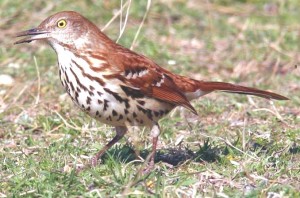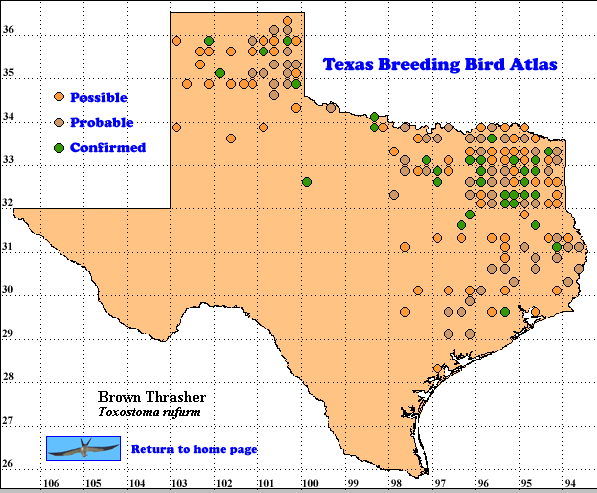A resident of brushy areas the Brown Thrasher breeds in north Texas; the range is extended southward in winter with the arrival of migrants from further north. The overlap of wintering and breeding ranges can cause problems in interpretation of “possible” and “probable” breeding evidence. Atlasers had to be careful in assigning “breeding” evidence. Another possibility for error in southern Texas is confusion with the similar Long-billed Thrasher (T. longirostre). The “long-bill” is only slightly longer than that of Brown Thrasher. Normal breeding ranges of these two thrashers do not overlap, but the winter range of Brown Thrasher overlaps the breeding range of Long-billed Thrasher. Thus the possible and probable records south of the 29th parallel may represent late migrating Brown Thrashers or Long-billed Thrashers.
Because Brown Thrasher nests are often concealed in thick bushes, hedgerows or brush piles, they are not easy to find. Only 3% of the total of breeding observations were of nests, and only 16% of the observations were confirmed.
DISTRIBUTION: During the 1987-1992 field work period of the TBBA project the data gathered indicate the largest concentration of Brown Thrasher breeding records is found in the Pineywoods region. Here 67% of all reports from the area north of the 29th parallel and east of the 98th meridian. These two lines intersect southeast of San Antonio. More than one third (37%) of all reports came from the 4 latilong blocks at the northeast corner of the state (north of the 32nd parallel and east of the 96th meridian, intersecting near Cayuga, Freestone County). Another 27% of breeding reports came from the northeastern Panhandle, near the Red River. The two areas (east Texas and the northeastern Panhandle) account for 94% of all reports. The remainder are widely scattered.
In winter migrants arriving from the north extend the range of Brown Thrasher further south in the state.
Outside Texas the Brown Thrasher is a fairly common breeding bird in eastern North America. The summer range extends north to Maine, the southern parts of Quebec, Ontario, Manitoba and Saskatchewan, south through the eastern United States to the Gulf Coast, and west to the Rocky Mountains and western Oklahoma.
Brown Thrashers winter in the southeastern United States, west to Oklahoma and Texas. The species has been reported as a vagrant in most states and provinces outside its normal range, and in northern Mexico, the Bahamas, Cuba, Bermuda and Europe (Cavitt and Haas 2000).
SEASONAL OCCURRENCE: Earliest and latest wintering dates for the species in Texas are September 5 and May 23. The breeding season of mid-March to late June (earliest egg date, April 19) overlaps the latest winter departure date (Oberholser 1974). A nest with young was found April 15, 1987 in latilong 33094, quadrangle A6 by a TBBA investigator.
BREEDING HABITAT: In both winter and summer, the Brown Thrasher is found in thickets and brushy edges of woodland. Yapon (Ilex vomitoria) is a favorite cover plant. The nest is placed in a bush or small tree, usually 0.9 – 2.4 m (3 – 8 ft) above ground, but occasionally on the ground. The nest is a rough, bulky cup of twigs, sticks, strips of bark, grass, weed stalks, rootlets and leaves, all firmly interwoven. The nest is lined with bark of grapevine and other woody plants, fine roots, grass, weed stalks, leaves, horsehair and a few feathers.
The female lays 3-6 eggs (Oberholser 1974), commonly 4, indistinguishable from those of Long-billed Thrasher. The incubation period is 12-13 days (Harrison 1979) and the nestling period ranges from 9-13 days (Cavitt and Haas 2000).
STATUS. Brown Thrasher is an uncommon to locally common summer resident in its breeding range (Lockwood and Freeman 2004), Little if any change in its breeding range seems to has occurred since the 1960’s. Any apparent difference between Oberholser’s (1974) map (summer and breeding locations) and the TBBA map may not be significant since the early map has fewer data points.
North American Breeding Bird Survey (BBS) data for Texas indicate an apparent decline in the breeding population for the period 1966-2004 (95% confidence range -4.9 to 0.7% population change per year, 19 times out of 20 the actual value will fall between these two figures). The statistically significant North American decline is -1.2% per year for the same period. The area of highest rate of annual decline is northern New England (-9.2%; Sauer et al. 2005). This drastic decline may result from continuing conversion of brushy fields to forest or houses.
The Brown Thrasher’s breeding range in Texas is about 1% of its North American range, as suggested by comparison of the number (32) of Texas BBS routes on which the species was detected to the total number (2283) of routes in North America where Brown Thrashers were found (Sauer et al. 2005).
In winter Brown Thrasher is common to uncommon (Oberholser 1974, Lockwood and Freeman 2004) east of a line from Corpus Christi north past Fort Worth (Christmas Bird Count data). It is a common winter resident at Welder Wildlife Refuge in Sinton (Fischer 1981). In parts of Texas, the species is present all year, although perhaps not the same individuals. Many birdwatchers in Texas live within the winter range of the Brown Thrasher.
As long as brushy places are present in abundance in eastern Texas, the Brown Thrasher should continue as a part of the avifauna in this state. Its fate as a summer resident is more problematic. because of its continued decline.
Text by Robert C. Tweit (2006)
Literature cited:
Cavitt, J. F., and C. A. Haas. 2000. Brown Thrasher (Toxostoma rufum). In The birds of North America, No. 557 (A. Poole and F. Gill, eds.). The Birds of North America, Inc. Philadelphia, PA.
Fischer, D. H. 1981. Wintering ecology of thrashers in southern Texas. Condor 83: 340-346.
Harrison, H. H. 1979. A Field guide to western birds’ nests. Houghton-Mifflin, Boston.
Lockwood, M. W. and B. Freeman. 2004. The TOS handbook of Texas birds. Texas A&M University Press, College Station.
Oberholser, H. C. 1974. The bird life of Texas. University of Texas Press, Austin.
Sauer, J. R., J. E. Hines, and J. Fallon. 2005. The North American Breeding Bird Survey, results and analysis 1966-2004 Version 2005.1. USGS Patuxent Wildlife Research Center, Laurel MD (Web site, http://www.mbr-pwrc.usgs.gov/bbs).

